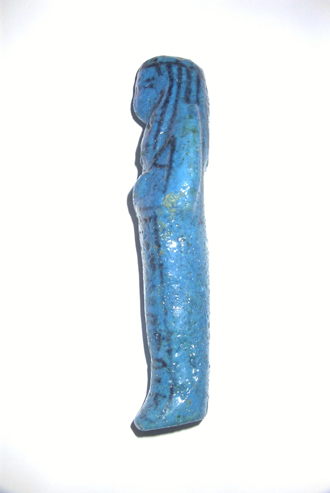Description
Name owner:
Title owner: The Osiris, scribe of the temple of Mut
Dimensions (hxwxd): 14.5 x 4.5 x 3.0 cm
Translation hieroglyphs: (1) Ushabti say: Transform into a Phoenix (?) or irrigate the lands
(2) The Osiris, the Scribe of the Temple of Mut, Nesi-per-Nub, true of voice
Preservation: Intact
R-R: 176.2
Provenance: –
Comments: Another online première at SC is this shabti for Nesi-per-Nub, one of the important priests in the second Cache of Deir El Bahri. This man was according to his sarcophagus in Vienna (see Niwinsky, 21th Dynasty coffins from Thebes, nr. 417, page 178) a: “Godsfather of Amun, Khonsu and Mut and a Scribe of the Temple of Mut. Also he was a Priest of Toth, Chief of the big palace, Great Controller (rDw) and (in French:) Confiance.” According to Kitchen, The Third Intermediate Period in Egypt, page 219-221, Nesipernub was married to Nesi-Mut (i) and was the Grandfather of the famous 4th Prophet of Amun called Nakhtefmut (A) also known as DjedtuthefAnhk starting a line of 4th Prophets of Amun.
His shabtis are rare and feature a even rarer extraction of Chapter 83 of the book of the dead,which deals with the transformation into a Phoenix (see Araujo page 513). The text is different on most shabtis, sometimes the title Godsfather of Amun is part of the text. The transliteration for this shabti is: wSbti, Dd, iri r bnw i, Asir, ssh ntjr mwt, ns(i)-pr-nb, maA-Chrw. However, others argue based on the glyphs on the coffin in Vienna that the bird pictured (Gardner G31) is the “heron”. In that case the transliteration should be: wSbti, Dd, iri r Snty, Asir, ssh ntjr mwt, ns(i)-pr-nb, maA-Chrw. In that case the link with Chapter 83 becomes vague since that Chapter depicts the same bird but with the glyphs supporting “bnw” (see E.A. Wallis Budge, the egyptian book of the dead, ISBN 0-486-21866-x, plate XXVII, page 176. I personally believe a this point that this bird on the shabti is linked to the title of Priest of Toth (sometimes described as bnw), so that Chapter 83 is the most likely explanation. The translation as mentioned in Aubert Cache 2 as from Chapter 6 to irrigate the lands seems incorrect since it does not link to any of the glyphs on the shabti. However, according to Scholgl-Brodbecke the bird can also mean to irrigate the riparian lands. This remains unclear!
The shabtis are from a high quality and some feature a necklace with an amulet, which is extremely rare for a Cache 2 shabti. It appears to be a heart amulet.
Published parallels can be found in Scholgl-Brodbecke, Uschebtis, page 230, Newberry, part III, plate XXXIV (worker) and plate XXXVII overseer), part I provides the description on page 50-52 and in Aubert Cache 2, nr. 24 page 76. For an overview of the museum collections see also Aubert Cache 2 and G. Janes nr. 52.
In 2021 a parallel publication was prepared by Patrice Renault. Finally, in 2021 it was included in the cache 2 page of Dik van Bommel’s site.







